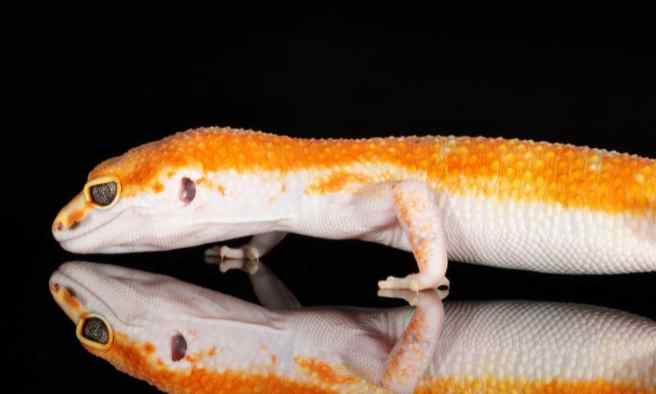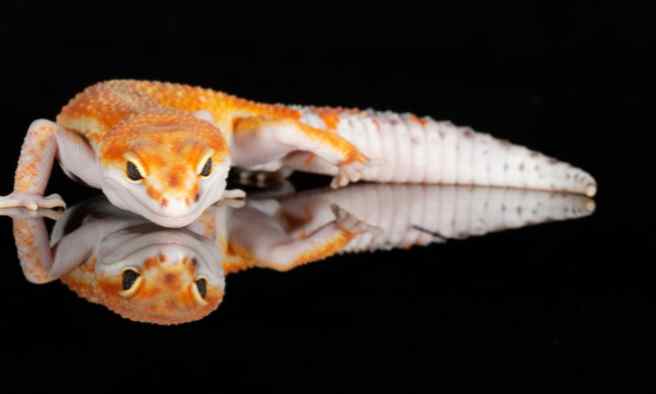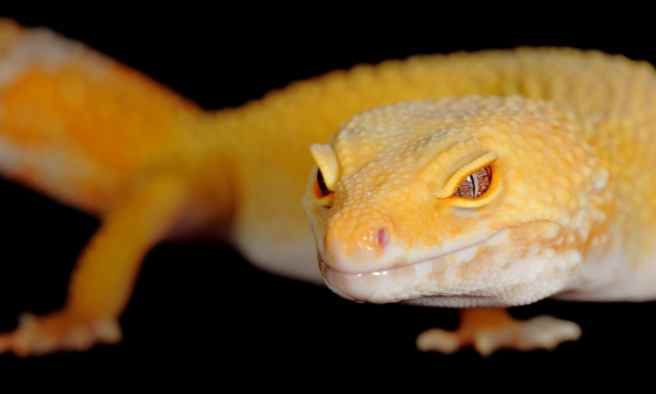Are you a proud owner of a leopard gecko? Have you ever wondered what your leopard gecko does at night when everyone is asleep? If so, then you’ve come to the right place. Leopard geckos are nocturnal reptiles, meaning that in the wild they would be most active during the evening and nighttime hours after sunset.
However, having them as pets at home can bring many questions about their behavior and routine – What do they eat? How much should I feed them? And more importantly – what do leopard geckos do at night while we sleep? Read on for helpful insights into these curious critters’ nocturnal routines!

Leopard Geckos’ Nocturnal Habits
Leopard geckos are among the fascinating creatures of the reptile world, known for their nocturnal habits that set them apart from many other gecko species. When the sun goes down, these endearing reptiles spring to life, exploring their environment, hunting for food, and engaging in social interactions.
The reason behind their nighttime activity lies in their remarkable adaptability to survive in the harsh environments of their natural habitat, which includes regions of the Middle East and Asia.
As the daytime temperature soars, leopard geckos seek refuge in cool crevices and burrows, conserving their energy for when night falls and the desert comes alive with a symphony of sounds and sights.
For reptile enthusiasts, observing the distinct nocturnal behavior of leopard geckos offers a captivating glimpse into the mysterious lives of these little creatures with their brightly patterned skin, wide eyes, and gentle demeanor.
Exploring the Night – How Leopard Geckos Spend Their Nights
Leopard geckos are fascinating nocturnal creatures, revealing a hidden aspect of their lives when the sun sets. As they venture out into the darkness, these tiny reptilians showcase incredible sensory abilities, adapting to their environment and ensuring their survival.
Armed with heightened vision, they skillfully navigate through the night to locate their prey, such as insects and arachnids. Patience and stealth allow leopard geckos to ambush their unsuspecting targets, contributing to a thrilling dance of predator and prey.
Not only do they engage in hunting, but nighttime is also when the geckos communicate with fellow members of their species, establishing social hierarchies and seeking potential mates. Amidst the enchanting moonlight, leopard geckos enchant us as they reveal their secret lives beneath the veil of darkness.

Hunting for Food – What Types of Prey Do Leopard Geckos Eat at Night
As the sun sets and darkness descends upon the landscape, leopard geckos, with their strikingly colorful and patterned bodies, embark on their nightly hunt for sustenance. These nocturnal predators have a diverse palette and are on the prowl for a variety of live prey, such as crickets, mealworms, superworms, waxworms, and even an occasional small pinkie mouse. The geckos utilize their keen senses and stealthy movements to effectively stalk their unsuspecting prey, before seizing it with a swift lunge and powerful bite. The consumption of this diverse range of nutrition not only satiates their hunger but also supplies them with essential vitamins and minerals to maintain optimal health. Therefore, the nightly hunting rituals of leopard geckos serve as an essential and fascinating aspect of their behavior and survival in the wild.
Socializing After Dark – How Leopard Geckos Interact with Other Animals at Night
Under the cover of darkness, a remarkable social life unfolds amongst the nocturnal creatures of the animal kingdom. Leopard geckos, in particular, exhibit fascinating interactions with other animals as the sun sets and their nightly activities begin.
Curiously venturing out of their hiding spots in search of food, these small reptiles showcase an astonishing level of adaptability and social skills. The bright and intricate patterns adorning their bodies, which serve as camouflage against potential predators during daylight hours, transform into powerful displays of communication after dark.
Communicating through a complex system of body language, vocalizations, and even pheromones, leopard geckos deftly negotiate various social scenarios, such as approaching a potential mate, establishing territory, or engaging in spirited skirmishes with competitors.
By observing and studying these captivating interactions, we gain valuable insights into the rich and diverse social structure that exists within the enigmatic world of these nocturnal reptiles.
So, as dusk falls and we settle down for the night, know that just beyond our walls, leopard geckos are beginning to embark on their nightly adventures – a world of socializing after dark that we are only just beginning to understand.
Keeping Warm in the Dark – How Leopard Geckos Retain Heat During the Night
In the fascinating world of reptiles, one creature that truly stands out for its incredible ability to regulate its body temperature is the leopard gecko. These captivating creatures have developed a remarkable strategy to keep warm during the cold, dark nights, ensuring their survival in a variety of harsh environments.
Contrary to popular belief, their ability to retain heat is not due to any internal process, but rather their resourceful use of environmental resources. By taking advantage of sun-soaked rocks and other heat-absorbing surfaces, leopard geckos store warmth throughout the day, which then serves as a cozy source of heat to cuddle up against once the sun sets.
Leaning on this advantageous behavior not only ensures the gecko’s survival by protecting them against low temperatures but also speaks volumes about their exceptional adaptability and resilience.
How incredible it is to witness the extraordinary intelligence found in the animal kingdom, especially in the seemingly small wonders like the leopard gecko.

Getting the Rest They Need – Where and How Long Do Leopard Geckos Sleep at Night
Leopard geckos are fascinating creatures, known for their stunning appearance and nocturnal habits. These enchanting reptiles require adequate sleep to thrive, and it’s crucial to understand their sleeping patterns and preferences to provide them with the perfect environment.
In their natural habitat, leopard geckos snooze during the day, retiring to concealed locations such as burrows and crevices to avoid predators and escape the harsh desert heat. When kept as pets, they appreciate hideaways within their enclosures; providing them with multiple hiding spots can offer a sense of security and promote healthy sleep.
As for how long these intriguing geckos sleep, they typically rest for around 10-12 hours during daylight. Astonishingly, they even possess eyelids, making it easier to determine when they’re catching some zzz’s!
By learning about their sleeping habits, you can create a haven for your pet leopard gecko, ensuring they get the rest that they need to flourish.
Overall, leopard geckos are amazing creatures that can be observed to truly understand how nocturnal animals behave.
They forage for food, interact with other animals and make sure to keep themselves warm in the dark. In addition to this, they rest when necessary – usually in hiding spots or burrows that remain cool even at night.
These fascinating reptiles have been around for millions of years and provide numerous lessons about adaptation and survival.
With humans now outlasting the natural darkness of the evenings, we can give these creatures a break from our presence and observe from a distance how they navigate their nights.
Related posts:

Hi – I’m Erika, the lead gecko enthusiast here at Geckopedia! I write articles about pet geckos, including what to feed your leopard gecko and how to help your pet gecko live a long, happy life! I graduated with advanced degrees from UC-Berkeley, the University of Southern California (USC) and Indiana University-Bloomington, where I studied Biology and Animal Science. I use my experience to help others learn about gecko care, and I am an advocate for all topics gecko related!
